影视音乐外文文献及翻译
外文文献翻译译稿和原文
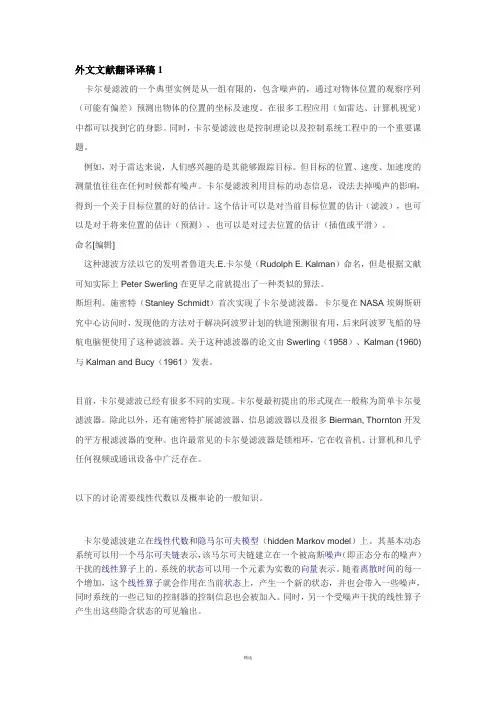
外文文献翻译译稿1卡尔曼滤波的一个典型实例是从一组有限的,包含噪声的,通过对物体位置的观察序列(可能有偏差)预测出物体的位置的坐标及速度。
在很多工程应用(如雷达、计算机视觉)中都可以找到它的身影。
同时,卡尔曼滤波也是控制理论以及控制系统工程中的一个重要课题。
例如,对于雷达来说,人们感兴趣的是其能够跟踪目标。
但目标的位置、速度、加速度的测量值往往在任何时候都有噪声。
卡尔曼滤波利用目标的动态信息,设法去掉噪声的影响,得到一个关于目标位置的好的估计。
这个估计可以是对当前目标位置的估计(滤波),也可以是对于将来位置的估计(预测),也可以是对过去位置的估计(插值或平滑)。
命名[编辑]这种滤波方法以它的发明者鲁道夫.E.卡尔曼(Rudolph E. Kalman)命名,但是根据文献可知实际上Peter Swerling在更早之前就提出了一种类似的算法。
斯坦利。
施密特(Stanley Schmidt)首次实现了卡尔曼滤波器。
卡尔曼在NASA埃姆斯研究中心访问时,发现他的方法对于解决阿波罗计划的轨道预测很有用,后来阿波罗飞船的导航电脑便使用了这种滤波器。
关于这种滤波器的论文由Swerling(1958)、Kalman (1960)与Kalman and Bucy(1961)发表。
目前,卡尔曼滤波已经有很多不同的实现。
卡尔曼最初提出的形式现在一般称为简单卡尔曼滤波器。
除此以外,还有施密特扩展滤波器、信息滤波器以及很多Bierman, Thornton开发的平方根滤波器的变种。
也许最常见的卡尔曼滤波器是锁相环,它在收音机、计算机和几乎任何视频或通讯设备中广泛存在。
以下的讨论需要线性代数以及概率论的一般知识。
卡尔曼滤波建立在线性代数和隐马尔可夫模型(hidden Markov model)上。
其基本动态系统可以用一个马尔可夫链表示,该马尔可夫链建立在一个被高斯噪声(即正态分布的噪声)干扰的线性算子上的。
系统的状态可以用一个元素为实数的向量表示。
影视视频剪辑外文文献翻译字数3000多
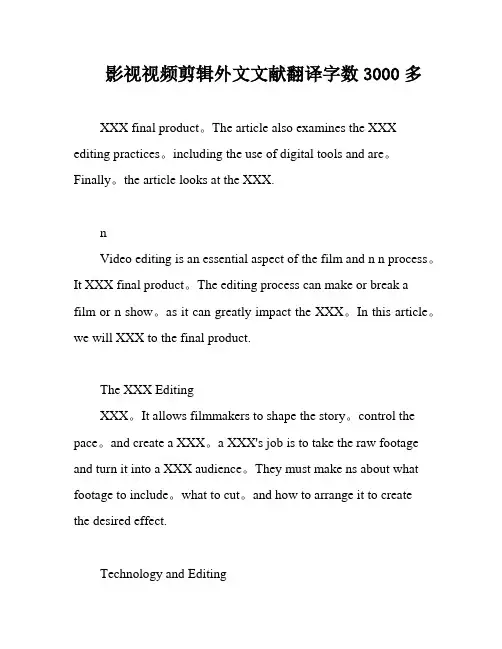
影视视频剪辑外文文献翻译字数3000多XXX final product。
The article also examines the XXX editing practices。
including the use of digital tools and are。
Finally。
the article looks at the XXX.nVideo editing is an essential aspect of the film and n n process。
It XXX final product。
The editing process can make or break afilm or n show。
as it can greatly impact the XXX。
In this article。
we will XXX to the final product.The XXX EditingXXX。
It allows filmmakers to shape the story。
control the pace。
and create a XXX。
a XXX's job is to take the raw footage and turn it into a XXX audience。
They must make ns about what footage to include。
what to cut。
and how to arrange it to createthe desired effect.Technology and EditingTechnology has XXX。
Digital tools and are have made the process faster。
more efficient。
and XXX。
collaborate with others in real-time。
影视音乐赏析论文
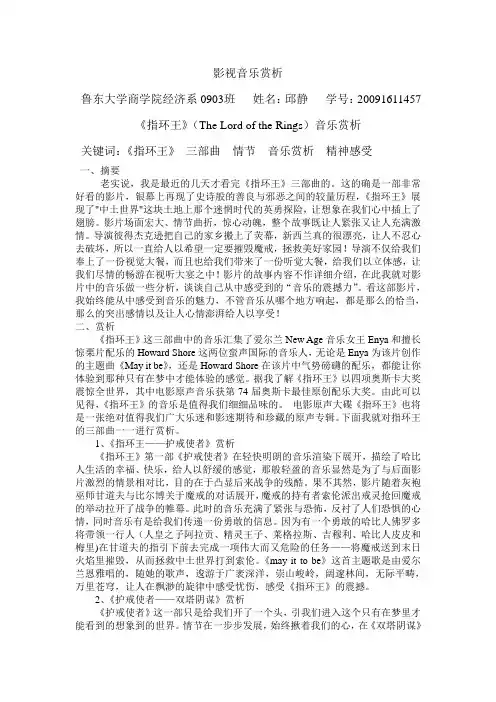
影视音乐赏析鲁东大学商学院经济系0903班姓名:邱静学号:20091611457 《指环王》(The Lord of the Rings)音乐赏析关键词:《指环王》三部曲情节音乐赏析精神感受一、摘要老实说,我是最近的几天才看完《指环王》三部曲的。
这的确是一部非常好看的影片,银幕上再现了史诗般的善良与邪恶之间的较量历程,《指环王》展现了"中土世界"这块土地上那个迷惘时代的英勇探险,让想象在我们心中插上了翅膀。
影片场面宏大、情节曲折,惊心动魄,整个故事既让人紧张又让人充满激情。
导演彼得杰克逊把自己的家乡搬上了荧幕,新西兰真的很漂亮,让人不忍心去破坏,所以一直给人以希望一定要摧毁魔戒,拯救美好家园!导演不仅给我们奉上了一份视觉大餐,而且也给我们带来了一份听觉大餐,给我们以立体感,让我们尽情的畅游在视听大宴之中!影片的故事内容不作详细介绍,在此我就对影片中的音乐做一些分析,谈谈自己从中感受到的“音乐的震撼力”。
看这部影片,我始终能从中感受到音乐的魅力,不管音乐从哪个地方响起,都是那么的恰当,那么的突出感情以及让人心情澎湃给人以享受!二、赏析《指环王》这三部曲中的音乐汇集了爱尔兰New Age音乐女王Enya和擅长惊栗片配乐的Howard Shore这两位蛮声国际的音乐人,无论是Enya为该片创作的主题曲《May it be》,还是Howard Shore在该片中气势磅礴的配乐,都能让你体验到那种只有在梦中才能体验的感觉。
据我了解《指环王》以四项奥斯卡大奖震惊全世界,其中电影原声音乐获第74届奥斯卡最佳原创配乐大奖。
由此可以见得,《指环王》的音乐是值得我们细细品味的。
电影原声大碟《指环王》也将是一张绝对值得我们广大乐迷和影迷期待和珍藏的原声专辑。
下面我就对指环王的三部曲一一进行赏析。
1、《指环王——护戒使者》赏析《指环王》第一部《护戒使者》在轻快明朗的音乐渲染下展开,描绘了哈比人生活的幸福、快乐,给人以舒缓的感觉,那般轻盈的音乐显然是为了与后面影片激烈的情景相对比,目的在于凸显后来战争的残酷。
影视音乐赏析文案
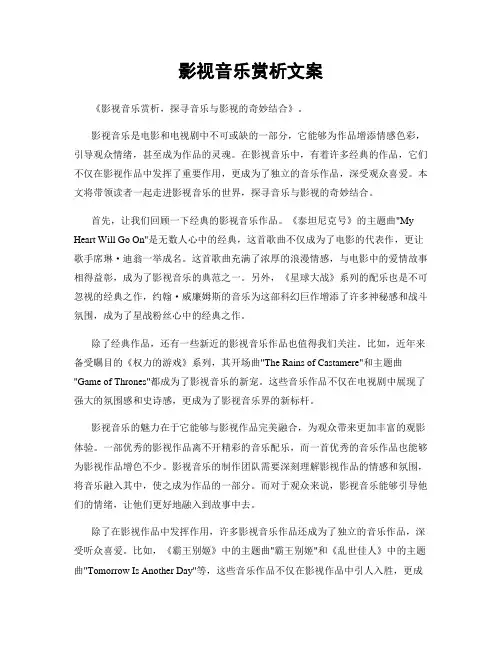
影视音乐赏析文案《影视音乐赏析,探寻音乐与影视的奇妙结合》。
影视音乐是电影和电视剧中不可或缺的一部分,它能够为作品增添情感色彩,引导观众情绪,甚至成为作品的灵魂。
在影视音乐中,有着许多经典的作品,它们不仅在影视作品中发挥了重要作用,更成为了独立的音乐作品,深受观众喜爱。
本文将带领读者一起走进影视音乐的世界,探寻音乐与影视的奇妙结合。
首先,让我们回顾一下经典的影视音乐作品。
《泰坦尼克号》的主题曲"My Heart Will Go On"是无数人心中的经典,这首歌曲不仅成为了电影的代表作,更让歌手席琳·迪翁一举成名。
这首歌曲充满了浓厚的浪漫情感,与电影中的爱情故事相得益彰,成为了影视音乐的典范之一。
另外,《星球大战》系列的配乐也是不可忽视的经典之作,约翰·威廉姆斯的音乐为这部科幻巨作增添了许多神秘感和战斗氛围,成为了星战粉丝心中的经典之作。
除了经典作品,还有一些新近的影视音乐作品也值得我们关注。
比如,近年来备受瞩目的《权力的游戏》系列,其开场曲"The Rains of Castamere"和主题曲"Game of Thrones"都成为了影视音乐的新宠。
这些音乐作品不仅在电视剧中展现了强大的氛围感和史诗感,更成为了影视音乐界的新标杆。
影视音乐的魅力在于它能够与影视作品完美融合,为观众带来更加丰富的观影体验。
一部优秀的影视作品离不开精彩的音乐配乐,而一首优秀的音乐作品也能够为影视作品增色不少。
影视音乐的制作团队需要深刻理解影视作品的情感和氛围,将音乐融入其中,使之成为作品的一部分。
而对于观众来说,影视音乐能够引导他们的情绪,让他们更好地融入到故事中去。
除了在影视作品中发挥作用,许多影视音乐作品还成为了独立的音乐作品,深受听众喜爱。
比如,《霸王别姬》中的主题曲"霸王别姬"和《乱世佳人》中的主题曲"Tomorrow Is Another Day"等,这些音乐作品不仅在影视作品中引人入胜,更成为了独立的音乐经典,被人们传唱不衰。
影片歌曲中的历史或者以文艺文学作品
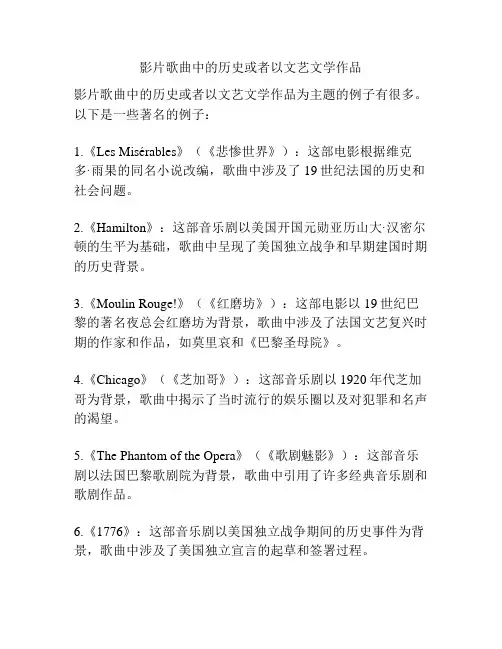
影片歌曲中的历史或者以文艺文学作品
影片歌曲中的历史或者以文艺文学作品为主题的例子有很多。
以下是一些著名的例子:
1.《Les Misérables》(《悲惨世界》):这部电影根据维克多·雨果的同名小说改编,歌曲中涉及了19世纪法国的历史和社会问题。
2.《Hamilton》:这部音乐剧以美国开国元勋亚历山大·汉密尔顿的生平为基础,歌曲中呈现了美国独立战争和早期建国时期的历史背景。
3.《Moulin Rouge!》(《红磨坊》):这部电影以19世纪巴黎的著名夜总会红磨坊为背景,歌曲中涉及了法国文艺复兴时期的作家和作品,如莫里哀和《巴黎圣母院》。
4.《Chicago》(《芝加哥》):这部音乐剧以1920年代芝加哥为背景,歌曲中揭示了当时流行的娱乐圈以及对犯罪和名声的渴望。
5.《The Phantom of the Opera》(《歌剧魅影》):这部音乐剧以法国巴黎歌剧院为背景,歌曲中引用了许多经典音乐剧和歌剧作品。
6.《1776》:这部音乐剧以美国独立战争期间的历史事件为背景,歌曲中涉及了美国独立宣言的起草和签署过程。
这些影片和音乐剧通过歌曲将历史和文艺文学作品与观众连接在一起,为故事增添了深度和情感。
这些作品在电影和音乐剧界都享有巨大的声誉,并成为了经典之作。
影视音乐欣赏论文
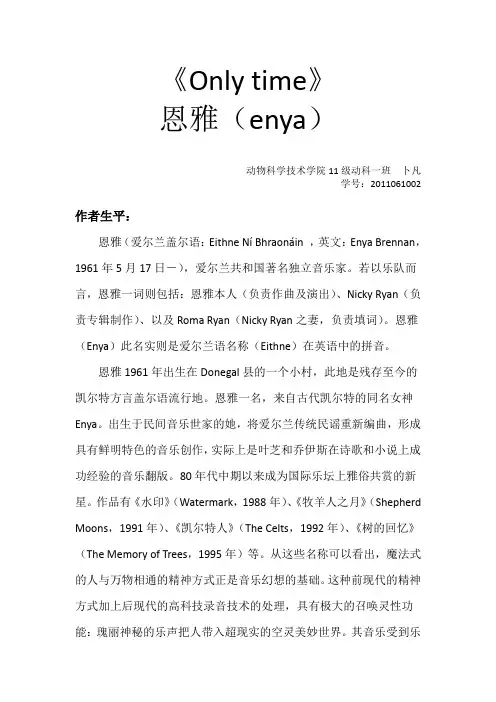
《Only time》恩雅(enya)动物科学技术学院11级动科一班卜凡学号:2011061002 作者生平:恩雅(爱尔兰盖尔语:Eithne Ní Bhraonáin ,英文:Enya Brennan,1961年5月17日-),爱尔兰共和国著名独立音乐家。
若以乐队而言,恩雅一词则包括:恩雅本人(负责作曲及演出)、Nicky Ryan(负责专辑制作)、以及Roma Ryan(Nicky Ryan之妻,负责填词)。
恩雅(Enya)此名实则是爱尔兰语名称(Eithne)在英语中的拼音。
恩雅1961年出生在Donegal县的一个小村,此地是残存至今的凯尔特方言盖尔语流行地。
恩雅一名,来自古代凯尔特的同名女神Enya。
出生于民间音乐世家的她,将爱尔兰传统民谣重新编曲,形成具有鲜明特色的音乐创作,实际上是叶芝和乔伊斯在诗歌和小说上成功经验的音乐翻版。
80年代中期以来成为国际乐坛上雅俗共赏的新星。
作品有《水印》(Watermark,1988年)、《牧羊人之月》(Shepherd Moons,1991年)、《凯尔特人》(The Celts,1992年)、《树的回忆》(The Memory of Trees,1995年)等。
从这些名称可以看出,魔法式的人与万物相通的精神方式正是音乐幻想的基础。
这种前现代的精神方式加上后现代的高科技录音技术的处理,具有极大的召唤灵性功能:瑰丽神秘的乐声把人带入超现实的空灵美妙世界。
其音乐受到乐评人和世界听众的热情追捧,多次荣登新时代音乐排行榜的冠军,乃至被誉为“New Age音乐之后”。
音乐成就:全球最畅销的十大女艺人第六位全球最畅销的欧洲女艺人全球最畅销的爱尔兰女艺人全球最畅销的新世纪音乐艺人全球最畅销的凯尔特音乐女艺人全球女子唱片五十强中拥有唱片数量最多(5张)的四位女艺人之一(其他分别是麦当娜,席琳.迪翁,玛丽亚.凯莉)拥有美国告示牌榜(Billboard)New Age榜历史冠军周数最多的艺人拥有美国告示牌榜(Billboard)New Age榜历史年终榜冠军最多的艺人拥有美国告示牌榜(Billboard)专辑200榜在榜周数最多的New Age艺人拥有英国金榜(UK Office)单曲榜上榜单曲最多的New Age艺人(16首)拥有英国金榜(UK Office)专辑榜上榜专辑最多的New Age艺人(10张)获得格莱美奖"最佳新世纪专辑"最多的独立艺人(4座)获得格莱美奖提名最多的New Age艺人(7次)获得世界音乐奖最多的New Age艺人(8座)音乐风格:new age音乐,作为新世纪音乐的代表人物之一,她的声音纯美安静,为我们洗涤尘世的浮躁。
影视音乐欣赏论文——(泰坦尼克号)
试赏析《泰坦尼克号》姓名:候海波学号:10064040专业:自动化摘要:电影是与音乐分不开的,在电影的一开场,就有体现电影精髓和主题的主题歌,每个特色的人物的出场都有体现出人物个性的音乐,每个剧情都有与情节完美结合的音乐作衬托,或扣人心弦,或让人融入其境。
关键词:《泰坦尼克号》主题音乐《My Heart Will Go On》《泰坦尼克号》英文名称为:《TITANIC》,导演是詹姆斯·卡梅伦(James Cameron),这部片长为 194 分钟的电影上映于1997年,一举夺得第69届奥斯卡最佳影片、最佳导演、最佳摄影、最佳音响、最佳电影剪辑、最佳艺术指导、最佳服装设计、最佳戏剧效果、最佳原创歌曲、最佳视觉效果、最佳声效剪辑等11项大奖。
故事讲述的是1985年,“泰坦尼克号”的沉船遗骸被发现。
美国探险家洛维特在船舱里看见了一幅画,102岁高龄的Rose声称她就是画中的少女,然后Rose就开始叙述她当年的故事:1912年4月10日,被称为“世界工业史上的奇迹”的“泰坦尼克号”从英国的南安普顿出发驶往美国纽约。
富家少女Rose与母亲及未婚夫Cal一道上船,另一边,不羁的少年画家Jack靠在码头上的一场赌博赢到了船票。
Rose不愿嫁给卡尔,打算投海自尽,被Jack抱住。
很快,美丽活泼的Rose与英俊开朗的Jack相爱了。
然而就在此时惨绝人寰的悲剧发生了,泰坦尼克号与冰山相撞。
Jack把生存的机会让给了爱人Rose,自己则在冰海中被冻死。
老态龙钟的Rose 讲完这段爱情后,把那串价值连城的“海洋之心”沉入海底,让它陪着Jack和这段爱情长眠海底……《泰坦尼克号》的主题曲是我们非常熟悉的《My Heart Will Go On》。
该曲在影片中共出现 11 次。
第一次出现是在开场时由女声演唱,用“啊”声代替原曲中的歌词,飘渺之中蕴含着安静,目的就是将观众引入泰坦尼克号的故事情节。
然而,之后每一次主题曲的出现,都有其深刻的含义。
影视音乐赏析论文
影视音乐赏析----音乐与剧情的交融电影是与音乐分不开的,在电影的一开场,就有体现电影精髓和主题的主题歌,每个特色的人物的出场都有体现出人物个性的音乐,每个剧情都有与情节完美结合的音乐作衬托,或扣人心弦,或让人融入其境。
在剧情中,音乐发挥了其特有的作用。
音乐以其特有的旋律和节奏为电影的每一个情节增添了无限的意蕴和魅力,让人切身其境,并在故事情节的发展上发挥了叙事的功能。
我们在课堂上欣赏了多类的作品,有配有柔和且充满对爱情守候着的音乐的电影《魂断蓝桥》,也有满是紧张气氛音乐的《黎明之前》,还有点缀英雄气概的音乐的《蜘蛛侠2》……每部电影都配有自己一套独特的音乐,或气势磅礴,或优雅动听。
音乐与电影的视觉效果一起展现在荧幕上,一方面推动着故事情节的发展,另一方面,增强了剧情的表现力。
电影情节与音乐的交融,刻画了人物的内心世界,塑造了完美的艺术形象。
就《雏菊》而言,穿插在《雏菊》中的音符那样的静谧柔和、自然美好,一如影片中那个爱雏菊的女孩,把一段伤感的爱情故事烘托得令人心醉。
黑管、钢琴、大提琴,旋律优雅伤怀,淡淡的,就像大簇的雏菊盛开在山野。
每当小雏菊的出现,都带来了一段自然美好的一段音乐,然而随着剧情和情节的发展,这段表面美好的音乐却暗含忧伤。
女主角惠英不一样的爱情经历,仿佛主题曲就在描绘着这么一段的不一样。
影片中穿插着古典音乐的悠扬气息,特别在杀手朴毅在场或在执行任务的时候,古典的气息就像在刻画着杀手的形象,也在为剧情的发展而渲染着悲伤的气氛,在柴可夫斯基不急不徐的乐曲伴奏中,时间如同沙漏中的细沙一般缓缓遗落。
然而时间不会在美好的时候驻足,弥漫着忧伤的城市街头暗潮汹涌,预示着我们所不想要的结局正悄悄的到来。
杀手组织派人杀死郑宇,并嫁祸于朴毅。
又一次广场对峙,终于明白真相的慧英举着那幅雏菊画,用唇语向着不知在何处的朴毅无声告白。
古典音乐回响着,和主题曲一起为剧情划上了一个伤感的句号。
而在《音乐之声》中,剧情与音乐的交融更是淋漓尽致。
中外影视音乐论文
品味音乐,品味人生(1)不同于《卧虎藏龙》里的中国古典基调,《夜宴》的电影音乐创作,是将中国音乐巧妙融入西方古典乐中。
它的旋律融合不少西方古典的华丽风格,同时具备五音阶的中国传统特色。
出自《楚辞;说苑;善说》的《越人歌》,是《夜宴》最重要的灵魂主题。
故事情节上,为了悼念纯粹的爱情,在厉帝误以为敌人尽除的夜宴上,率领家技班表演出王子生前最喜爱的《越人歌》。
以《越人歌》传神叙述兵荒马乱的社会中的爱情故事,与电影内容融为一体。
《夜宴》片尾曲:谭盾作曲、张靓颖演唱《我用所有报答爱》。
超级女声第三名出身的成都女子张靓颖,曾在大陆制作人张纪中《神雕侠侣》的原版主题曲出过声。
在《夜宴》的主题歌中,张靓颖有不少肺量充沛的嗓音,相比下李玟只适合唱流行歌曲,大雅之堂险末座了。
婉后章子怡在故事末尾被刺杀,临死前转头得知刺客身分后的一脸惊讶、胸口剑身被刺杀者抽离后随手丢入庭中小池塘的画面,这样并未交代观众刺客身分的开放式结局,搭配了她干净的声音,更显出华丽苍凉。
(2)《八月迷情》是一部以音乐为主线的电影。
在我看来,《八月迷情》应该说是一部音乐童话。
动人的音乐配上唯美的童话故事使得此部影片非常完美。
故事是从奥古斯特•拉什——莱拉与路易斯的孩子站在麦田间享受音乐,并将微风扫过麦穗的沙沙声变成宏大的交响乐的镜头中开始的,淡淡的背景音乐是整个影片蒙上了一层静谧与美好的感觉。
在莱拉和路易斯相遇之前,影片音乐演奏的过程中多次平行剪辑了路易斯在酒吧的个人演唱与莱拉在音乐厅的个人独奏,音乐声效上已经达到了完整统一的效果,这个段落安静舒适,营造了一个浪漫的爱情氛围。
这一段平行蒙太奇的主题就是浪漫与安谧。
而莱拉和路易斯初次相遇的场景,是在街头歌手演奏的《月宫舞》徐徐萦绕的旋律的牵引下,两人在一种安静的气氛中渐渐走到了一起,在这个时候,音乐就成了他们唯一能够分享的语言。
《月宫舞》在这个时候就起到了一种推进故事发展、烘托气氛的作用,同时也为整个影片奠定了音乐的基础。
影视音乐赏析论文
《影视音乐赏析》学院:经济治理学院班级:14农林经济治理学号:姓名:一、音乐简介《my heart will go on》中文名《我心永久》,闻名爱情电影Titanic《泰坦尼克号》主题曲,由好莱坞主流电影闻名作曲家詹姆斯·霍纳(James Horner)一手制作。
加拿大女歌手席琳·迪翁(Celine Dion)演唱,发行于1998年。
收录于《Let's Talk About Love》和Titanic(《泰坦尼克号》原声带)两专辑中。
Celine Dion的代表作,也是世界上最为人所熟知的歌曲之一。
具有浓郁民族韵味的爱尔兰锡哨,登上多国单曲榜第一名,是世界上最畅销的单曲之一。
取得第70届奥斯卡最正确电影歌曲大奖,第41届格莱美奖,最正确影视媒体作品歌曲,席琳·迪翁取得最正确流行女歌手。
中文名译为《我心永久》、《我心依旧》、《爱无止境》、《心与你相依》,意大利语名:il mio cuore va。
作为电影Titanic(中文名《泰坦尼克号》)的主题曲和片尾曲,Celine Dion的代表作,也是世界上最为人所熟知的歌曲之一。
它在美国、英国、法国、比利时、澳大利亚、丹麦、瑞士等多个国家/地域单曲榜,是世界上最畅销的单曲之一。
具有浓郁民族韵味的爱尔兰锡哨,精致编排,尽显悠扬婉转而又凄美动人。
歌曲的旋律从最初的平缓到激昂,再到缠绵悱恻的高潮,一直到最后荡气回肠的悲剧尾声,短短四分钟的歌曲事实上是整部影片的浓缩版本。
歌曲由韦尔·杰宁斯(Will Jennings )作词,中文歌词由中国今世童话作家王雨然译作,粤语版《系我心弦》由香港女歌手叶倩文演唱。
二、作曲家简介詹姆斯·罗伊·霍纳(James Roy Horner,1953年8月14日-2021年6月22日),美国闻名音乐人、作曲家,好莱坞最负盛名的电影配乐大师,诞生于加利福尼亚州洛杉矶。
- 1、下载文档前请自行甄别文档内容的完整性,平台不提供额外的编辑、内容补充、找答案等附加服务。
- 2、"仅部分预览"的文档,不可在线预览部分如存在完整性等问题,可反馈申请退款(可完整预览的文档不适用该条件!)。
- 3、如文档侵犯您的权益,请联系客服反馈,我们会尽快为您处理(人工客服工作时间:9:00-18:30)。
Hollywood Theory, Non-Hollywood Practice: Cinema Soundtracks in the 1980s and 1990s The Spectre of Sound: Music in Film and TelevisionExperiencing Music Video: Aesthetics and Cultural ContextAnnette Davison. , Hollywood Theory, Non-Hollywood Practice: Cinema Soundtracks in the 1980s and 1990s. Aldershot: Ashgate, 2004, 221 pp.K.J. Donnelly. , The Spectre of Sound: Music in Film and Television. lLondon: British Film Institute, 2005, 192 pp.Carol Vernallis. , Experiencing Music Video: Aesthetics and Cultural Context. New York, NY: Columbia University Press, 2004, 341 pp.Next SectionThe last time a collection of screen music-related books was the subject of a Screen review, the reviewer Simon Frith was moved to note each work's ‘self-defeating … need to draw attention to their subject's neglect’ as well as the very limited manner in which the authors seemed ‘to be engaged with each other’.1 Judging by the books grouped together in the present review, the scholarship in the area is now much more collegiate, and the requirement on the authors to self-diagnose academic isolation seems to have become unnecessary. Annette Davison, K.J. Donnelly and Carol Vernallis share a plethora of critical references on music–image relationships, from Theodor Adorno to Philip Tagg and many points in between.A substantial canon of academic writing on music in narrative film now exists, and it can no longer be claimed that music video is a scholarly blind spot (as Vernallis admits). Of the various media formats discussed in the books under review, only television music remains relatively under-represented academically (though Donnelly's two chapters on the subject begin the process of addressing this absence).In this context, the authors' task would appear to be to present alternatives to existing work, or to bring new objects of study to critical light. All three studies make claims for th eir own originality by referencing a model of ‘classical’ narrative film music practices: a conceptualization of the soundtrack's role as fitting in with classical cinema's perceived storytelling priorities. For all the books' individual merits, the regular recourse to notions of the classical, even in the service of its refutation, raises interesting questions about the possibility (or impossibility) of doing without such a concept entirely. Thus, these works reveal the ‘classical’ to be a category as prob lematic yet insistent in writing on music–image relations as it is in other areas of screen studies enquiry.As its title suggests, Davison's Hollywood Theory, Non-Hollywood Practice: Cinema Soundtracks in the 1980s and 1990s engages with classical film music theory most explicitly. Indeed, about a quarter of the book is devoted to the explication of, first, Classical Hollywood Cinema as it has been conceived academically, and second, the classical scoring practice associated with it (which Davison sees revived in the so-called ‘post-classical’ Hollywood of the mid 1970s onwards). This provides the ground on which Davison makes her key claim: The central argument of this book is that, by operating as a signifier of classical – and, indeed, New Hollywood cinema – the classical Hollywood score offered those making films outside and on the margins of Hollywood cinema in the 1980s and 1990s a further means by which they could differentiate their cinemas from Hollywood's, through the production of scores and soundtracks which critique or refer to this practice in particular ways (p. 59). There follow close analyses of four films whose soundtracks, according to Davison, refer to the classical model at the same time as they offer an alternative. Through her sequencing of the case studies, Davison outlines possibilities of alternative practice that range from a total deconstruction of the classical soundtrack's conventional storytelling functions (as witnessed in Jean-Luc Godard's Prenom: Carmen [1983]) to the identification of a scoring practice that mimics certain aspects of the classical in its collaborative nature, yet provides a utopian alternative to it (as seen through David Lynch's Wild at Heart [1990]). In between, she explores the notion of the soundtrack as a ‘liberating’ force (Derek Jarman's The Garden [1990]), and the potential for a compromise to be found between classical and alternative models (Wim Wenders' Wings of Desire [1987]).Davison's reading of each film is imaginative and very well detailed. She demonstrates a particular facility for identifying, and ascribing a significance to, different types of sound on the same soundtrack. This is done with particular success in her readings of The Garden and Wings of Desire. Her analysis does not seek to hide her evident musical training, but, in nearly all cases, remains intelligible and persuasive to non-musicologists such as myself (who will just have to accept the occasional use of musical notation as pretty pictures).It is questionable how much of the extremely comprehensive scene-setting undertaken by Davison in the book's early sections is necessary for an appreciation of the individual film analyses. Nevertheless, her summaries of discussions about classical and post-classical Hollywood cinema and the classical film score are exemplary, and they are conducted with a thoroughness which is understandable, perhaps, in a book which takes its place in the publisher's Popular and Folk Music series rather than in a screen studies collection.There remains a mismatch, however, between the concentration on Hollywood as an institutional, industrial and ideological force in the early chapters of the book, and the auteurist bent of the analysis that follows in later chapters. For example, the chapter on ‘New Ho llywood cinema and (post-?) classical scoring’ concludes with statistical information about US cinema's growth in the overseas market during the 1980s. Yet this detail seems unnecessary in the light of the subsequent interpretation of the various non-Hollywood soundtracks as imaginative responses to mainstream practices on thepart of individual filmmakers. The division between descriptions of Hollywood as intransigently institutional, and the implicit understanding of art-house cinema as a space for the free expression of the auteur (made explicit in the celebration of Lynch in the final case study) is made too complacently and means that Davison does not fulfil her promise to engage ‘with institutional issues in relation to film soundtracks and scores’ (p.6) in every case. In this respect, the book does not fully realize the potential of its many excellent parts.The critical tone of Donnelly's The Spectre of Sound: Music in Film and Television also fluctuates somewhat from section to section, although the reader is prepared for this by the author's early claim that the book is ‘a rumination, an investigation of some of the elusive and fascinating aspects of screen music’ (p. 3) rather than a mo re strictly hypothesis-based account.Nevertheless, more concrete justification is given for the book's attention to a pleasingly eclectic range of material, which includes the work of canonized auteurs such as David Lynch and Stanley Kubrick, but also makes room for a discussion of the soundtracks of Space: 1999, a whole range of horror movies, and the role of music in television continuity segments. Donnelly characterizes screen music as something more intangible than is claimed in the more classical accounts focusing on the score's overt storytelling functions. Inspired, in particular, by the increasingly complex sound design of films produced for release in cinemas, Donnelly argues: While film music traditionally has been conceived as part of narration, working for film narrative, in some ways it would be better to see it as part of the film's repository of special effects (p. 2).Determined to explore screen music's more ‘unruly’ qualities (at least when set against a narrative yardstick), Donnelly riffs around notions of music's ‘ghostliness’ in an imaginative manner. Particularly in relation to cinema, he sees the haunting activities of the soundtrack as constituting a kind of sensuous possession of the viewer. Donnelly (somewhat contentiously given the medium's technological advances) is less willing to admit to the possessing capabilities of television soundtracks, but concentrates instead on another kind of ‘haunting’: the habitual use of familiar music in television that evokes the spectre of its ‘lives’ elsewhere as much as it applies i tself to a particular televisual context.It is the notion of screen music as always indicating another place that most usefully ties the different strands of Donnelly's eclectic study together. Through this interest in the‘elsewhere’ of screen music, Do nnelly successfully probes areas outside the reach of classical narrative film music theory, which attends to the here and now of the soundtrack's involvement in a particular fictional scenario. However, the value of the insights which ensue from this successful escape from a more classical approach is sometimes taken for granted. Donnelly's analyses as a whole lack the attention to detail which is one of the virtues of Davison's case studies. The author anticipates this criticism early on by acknowledging that the book ‘provides a “long shot”, allowing the sort of synoptic view unavailable to detailed analysis, rather than the predominant “close-up” of many preceding film music studies’ (p. 3).The loss, in terms of analytical depth, that this critical strategy necessitates, is not always compensated for by the book's commendable breadth. For example, a relatively sustained analysis of Lynch's Lost Highway (1996) is not as convincing as it might be due to an unwillingness to provide sufficient evidence for its claims. On the film's heavy use of pre-existing pop songs, Donnelly comments: Are these song appearances simple‘comments on the action’? I don't think so. It is more as if the action emanates from the songs themselves, particularly from their grain of sound and rhythmic aspects (p. 28). This assertion is allowed to fend for itself, in the absence of more particular commentary about the interaction between the action and song in each specific case. The value of investigating screen music's less ‘submissive’ qualities in relation to narrative principles would be better advocated through a detailed interpretation that also engages with the possibility that the soundtrack fulfils more conventional storytelling functions. Characterizing the ‘elsewhere’ of sc reen music surely becomes more interesting if its relationship to other spaces is acknowledged and its own territory is mapped in detail.Vernallis's Experiencing Music Video: Aesthetics and Cultural Context combines the imaginative facility that fires Donnelly's book with the attention to detail that characterizes Davison's. Her study is extremely comprehensive in fulfilling its promise to take ‘the music of music video most seriously’ (p. x), thereby ‘attempting an analysis that takes musical codes, processes, and techniques as providing means by which video image can be structured’ (p. 209). On one level, as Vernallis admits, this is a belated consolidation of the initiatives taken in Andrew Goodwin's foundational music television study Dancing in the Distraction Factory: Music Television and Popular Culture.2 In its implementation, however, Vernallis far exceeds this brief. There are chapters on narrative and editing, as you might expect from a study whose aim it is to deconstruct the form of the music video; less expected is the attention to aspects such as supporting performers, props and the sensual qualities of (aural and visual) space, colour, texture and time.Even in the more predictable sections, Vernallis explores relationships between song and image which expand a critical understanding of the music video's possibilities. For instance, in the chapter on editing, she goes far beyond the standard notion that videos cut their images to the rhythm of the song, to suggest: Obviously, editing can reflect the basic beat pattern of the song, but it can also be responsive to all of the song's other parameters. For example, long dissolves can complement arrangements that include smooth timbres and long-held tones. A video can use different visual material to offset an important hook or a different cutting rhythm at the beginnings and ends of phrases. And, of course, these effects can switch from one-to-one relationships to something that is more contrapuntal (p. 49). These kinds of expressive possibilities are then illustrated through a great range of examples, all analysed with an interpretive richness that makes the inclusion of three extended case study chapters at the end of the book almost feel like too much of a good thing.In her afterword, Vernallis claims that her book ‘attempts to lay out the basic materials of music video, much as David Bordwell and his colleagues do for cinema in The Classical Hollywood Cinema or Film Art’ (p. 286). Experiencing Music Video will certainly prove useful as a textbook, and some of the unnecessary repetition between chapters may beexplained by an expectation that the book will be consulted in separate chunks on individual weeks of a course rather than as a whole. However, I feel that Vernallis is selling herself short with her comparison. There is an imaginative and idiosyncratic, yet disciplined, interpretive impulse behind her analysis which The Classical Hollywood Cinema3 explicitly rejects. Her book has more in common with the poetic categorizations of sound theorist Michel Chion or, casting the net more widely, the sensitive responses to the intricacies of a filmed fictional world demonstrated by George M. Wilson's Narration in Light: Studies in Cinematic Point of View.4 Both Wilson and Vernallis seize on‘moments’ which the a uthors then seek to explain in relation to their fictional world, whether that be a setting stimulated by dramatic possibilities, as in the case of narrative film, or musical parameters, as is the case with the music video. As Vernallis states, by attendin g to the smallest of moments, ‘it will be possible to work toward seeing how the video builds toward this moment and moves away from it’ (p. 202).On a number of occasions, even an attentive and immersed critic like Vernallis cannot resist the temptation to compare song–image relationships in the music video with the perceived ‘typical’ conventions of classical cinema and classical narrative film music. This necessitates a diversion from the book's primary, and most laudable, aim to fully understand the influence of the music of the music video.In all three books, the acknowledgement of a body of film music writing that can be categorized as ‘classical’ provides evidence of a now mature field of study. This literature is not always integrated seamlessly with the authors' own arguments. All three works provide illuminating insights into types of screen music that are not accounted for adequately by classical theory. However, the arguments work best when engaging carefully with the specific relationships observable and audible in their chosen objects of study, rather than looking over the shoulder towards models of classical narrative film music, or assuming the value of an analysis simply because it does not fit the classical mould. In the kind of text-based criticism pursued by all three writers, the most generous kind of critical activity can also be the most myopic. Vernallis's book, in particular, shows the rewards of a close reading of particular moments, as it produces insights which may inspire the reader to understand, in new and surprising lights, not only that moment, but others they encounter themselves.1.Ian GarwoodPrevious SectionFootnotes《好莱坞理论、非好莱坞实践:20世纪80年代至20世纪90年代的原声带电影》——声音的魅力:电影和电视剧中的音乐体验型的音乐视频:美学与文化语境最后一次收集的屏幕与音乐有关的书籍是主题为屏幕的专业评论,评论者是Simon Frith,她很感动,并注意到各项工作间的弄巧成拙......需要提请注意的是她们忽视主题以及非常有限的方式,在这种方式中,作者们似乎愿意相互帮助以完成工作。
